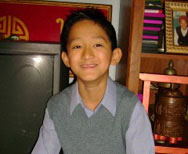"Everyone worked together. The doctors, nurses, social workers, everyone helped us get through this. I had lost my job during this time, so it was very hard for me and my wife. I really thank the doctors, and the whole crew. We did it."

While he may look and act like a typical fourth grader, 9-year-old Sangay is anything but average. Inside this quiet, dark-haired boy with the bright smile is a survivor who endured three separate bouts with cancer before the age of 5.
When he was just 19 months old, Sangay was diagnosed with Wilms tumor, the most common form of kidney cancer in children. He had been transferred from a hospital near his home in Hudson County to Children’s Hospital of New Jersey (CHoNJ), where pediatric hematology/oncology specialists would use their advanced expertise to quickly identify his disease.
At CHoNJ, Wondwessen Bekele, MD, Associate Director of the Valerie Fund Children’s Center for Cancer and Blood Disorders coordinated Sangay’s treatment. Surgeons removed the boy’s cancerous kidney, and then he underwent weekly chemotherapy at CHoNJ.
Wilms tumor is generally curable, but Sangay’s case would prove to be particularly challenging. Three months into his chemotherapy treatment, his family was dealt another blow – the Wilms tumor had spread into Sangay’s liver.
The Sherpas were devastated. Once again, they put their son’s life into the doctors’ hands. CHoNJ surgeons removed nearly three quarters of Sangay’s liver, then he began another round of intensive chemotherapy.
Sangay was cancer-free for two years when his doctors discovered yet another potentially deadly outcome of his original cancer: acute myelocytic leukemia (AML), a cancer of the blood that is the second most common form of leukemia.
According to Dr. Bekele, in rare cases the aggressive treatment of Wilms tumor can in time result in a secondary malignancy in the child. In Sangay’s case, that secondary malignancy was AML. His chance of survival was just 15 percent.
Doctors said to treat this disease, Sangay would have to endure another powerful round of chemotherapy, and if that was not effective, a bone marrow transplant. Sangay stayed in the hospital for nearly a month while he underwent chemotherapy. The treatment proved to be a lifesaver. He never required a bone marrow transplant.
Sangay has not required cancer treatment in 5 years, something his father Nurbu describes as a nightmare turned miracle. “It’s wonderful that I have my son now,” Nurbu Sherpa says.
“Everyone worked together. The doctors, nurses, social workers, everyone helped us get through this. I had lost my job during this time, so it was very hard for me and my wife,” says Nurbu. “I really thank the doctors, and the whole crew. We did it.”